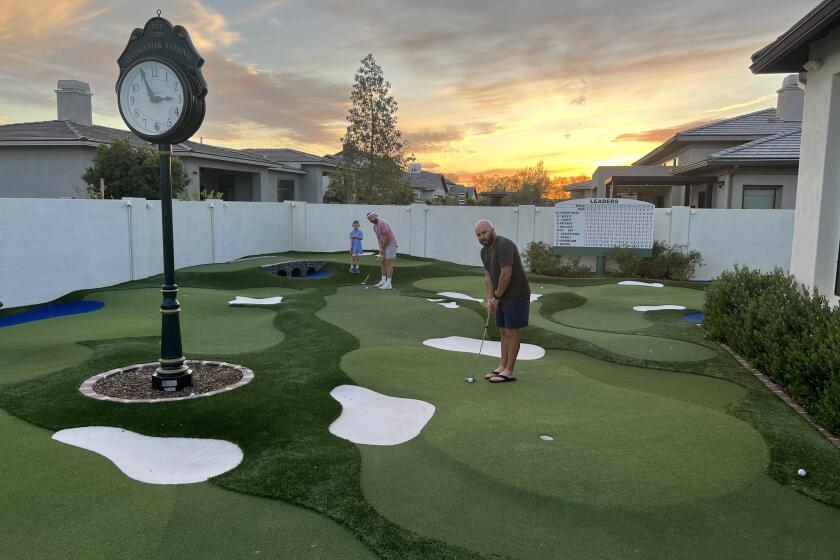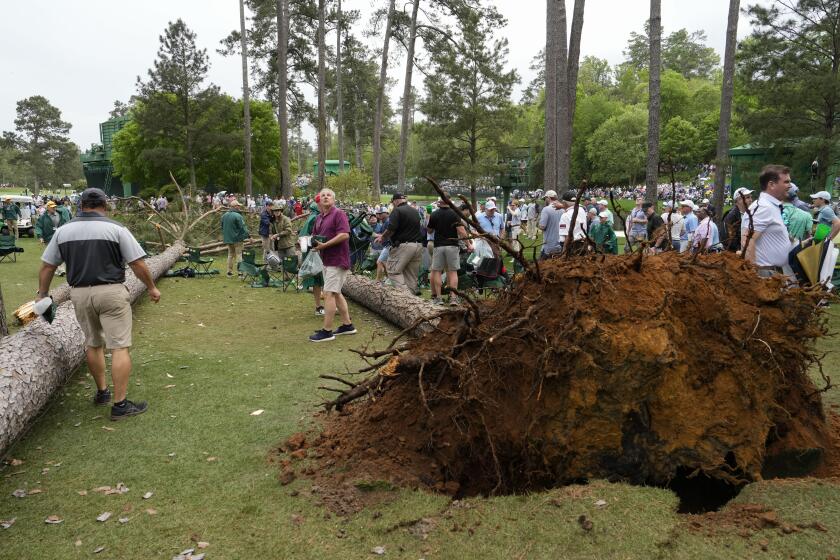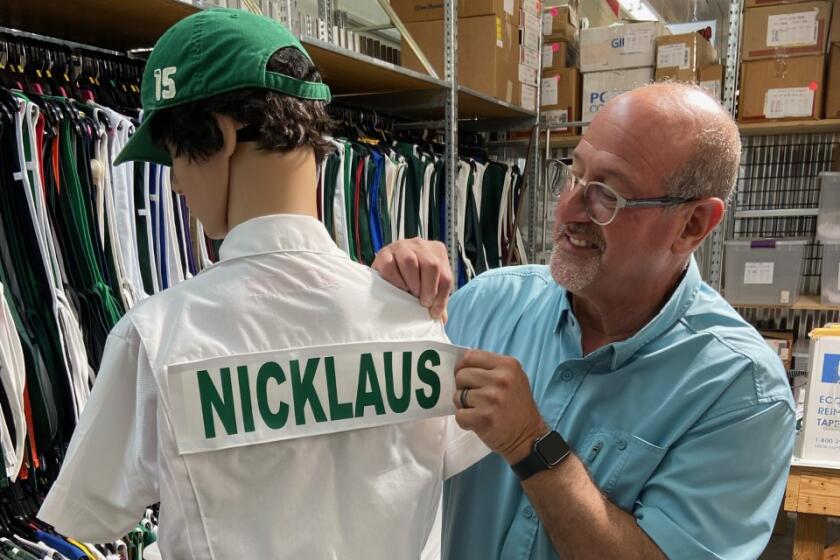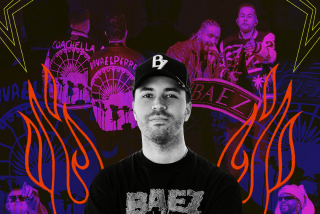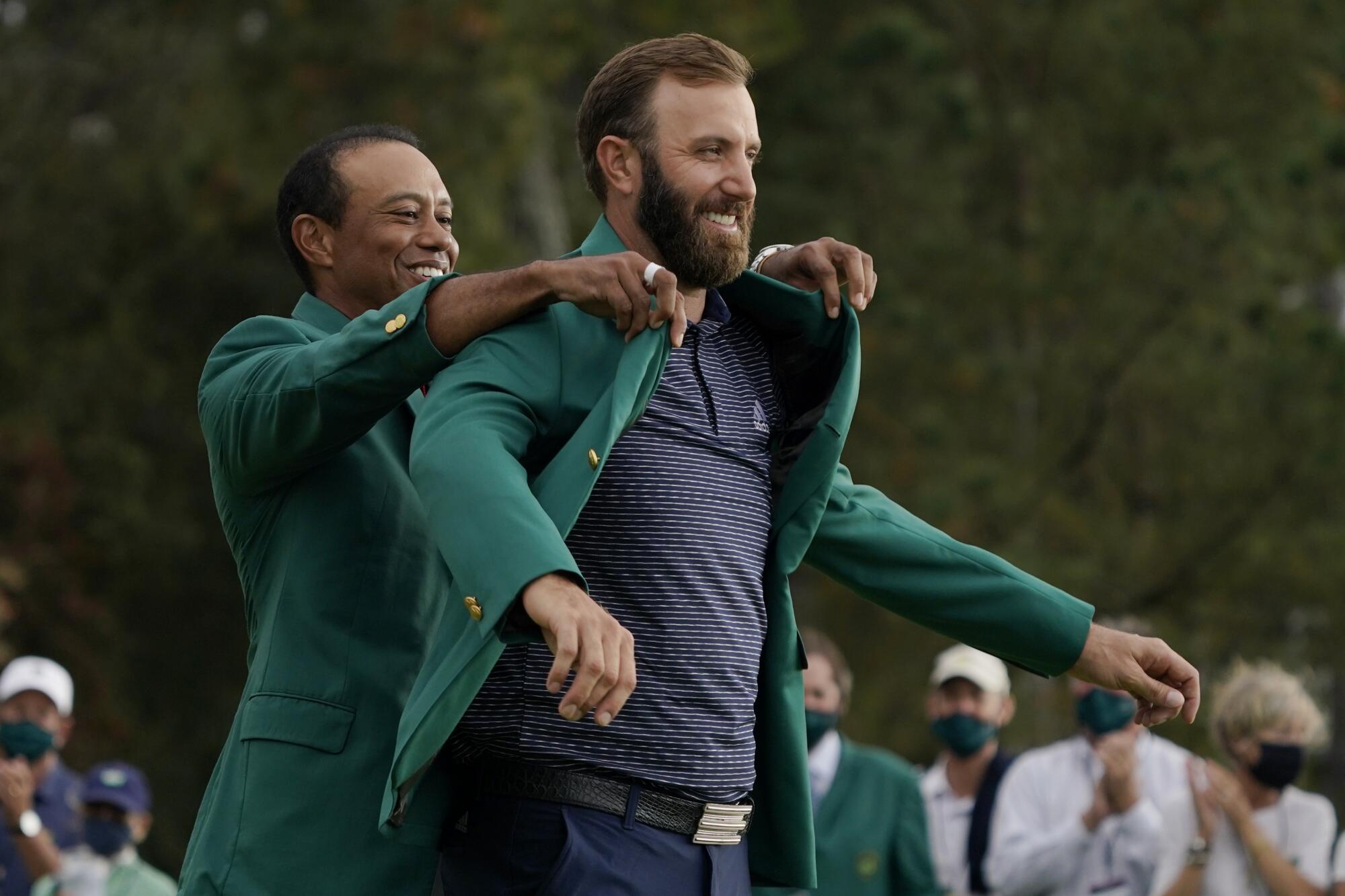
- Share via
AUGUSTA, Ga. — Tucked away in the back of the Augusta National pro shop is an unmarked wooden door. Behind it is a staircase that used to lead to an underground storage room.
Now, it’s a portal to an inner sanctum.
The ultra-exclusive golf club has created a secret space for green-jacket storytelling and tailoring that’s as richly appointed as a Savile Row clothier and has the high-tech touches of a Disney ride.
Constructed in 2021, the “Green Jacket Experience” and “Green Jacket Vault” were heretofore accessible only to club members and their guests. But Thursday, on the first day of the Masters, Augusta National provided The Times an exclusive and unprecedented look. No photos or video were permitted.
The green jacket is worn by club members and Masters champions, who first slip it on during the traditional winner’s ceremony at Butler Cabin, mere steps from the 18th green. The jacket is golf’s answer to the Lombardi Trophy or Stanley Cup and is so linked with world’s most-watched tournament that a lot of fans don’t realize there’s actually a Masters trophy, a replica of the clubhouse in sterling silver.
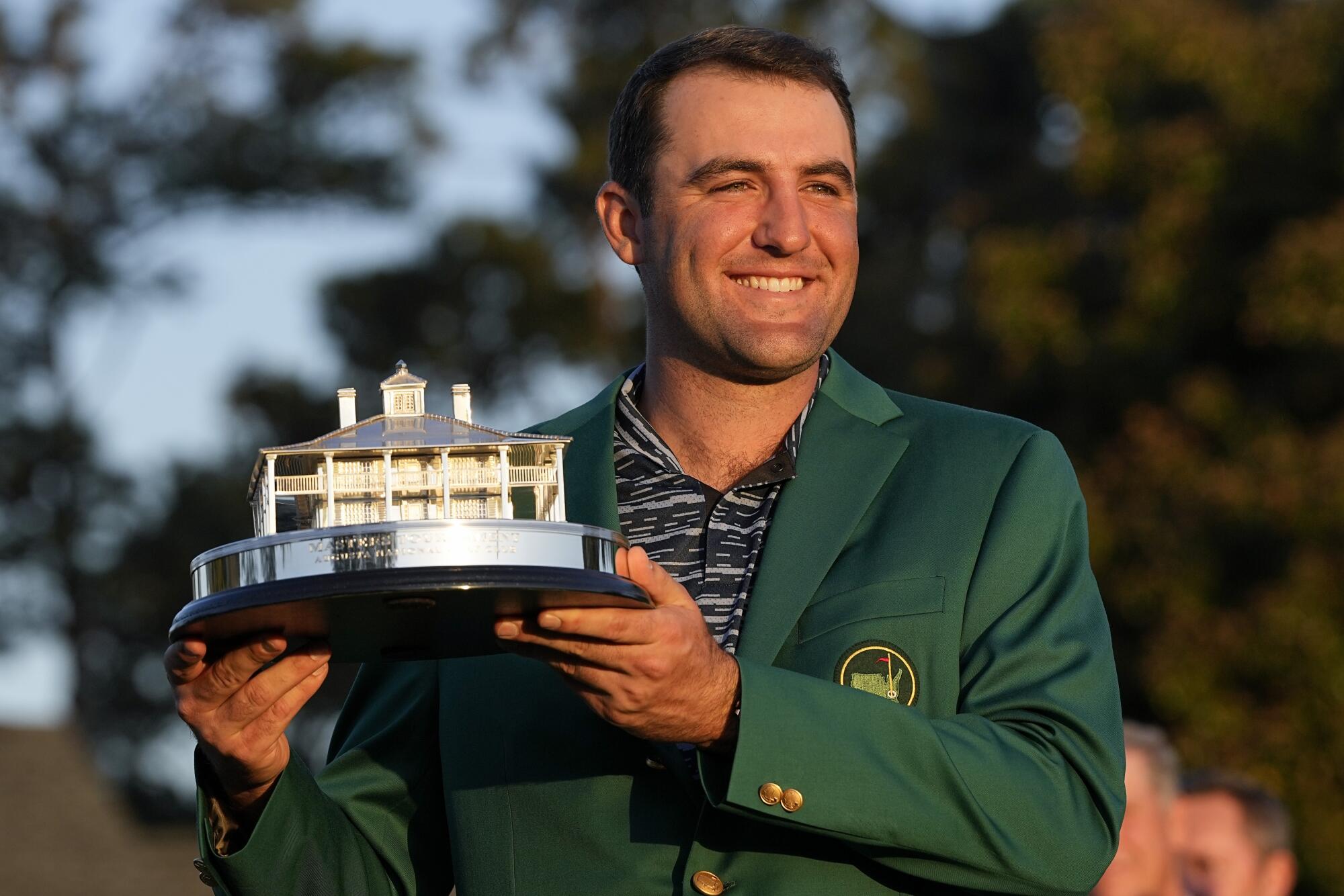
So synonymous are the coats and the club that members are referred to as simply “green jackets.”
“Everybody knows what the jacket is,” said Jordan Spieth, who won the 2015 Masters. “You carry a trophy around, and if you’re not a golf fan, you may get confused. But even non-golf fans know what the jacket is.”
There are all sorts of stories surrounding green jackets, from Jack Nicklaus not receiving his until more than a decade after he won his record sixth Masters, to Gary Player suggesting the club come “fetch it” after he unwittingly broke the rules by taking it home to South Africa, to the one that a Toronto thrift store — not knowing what it had — sold for $5.
Thousands of patrons spend millions of dollars per day in the various Masters merchandise shops around the course, structures that range from emporiums — jackets, shirts, ties, chairs, toys, glassware — to concession cabanas, which sell mostly caps.
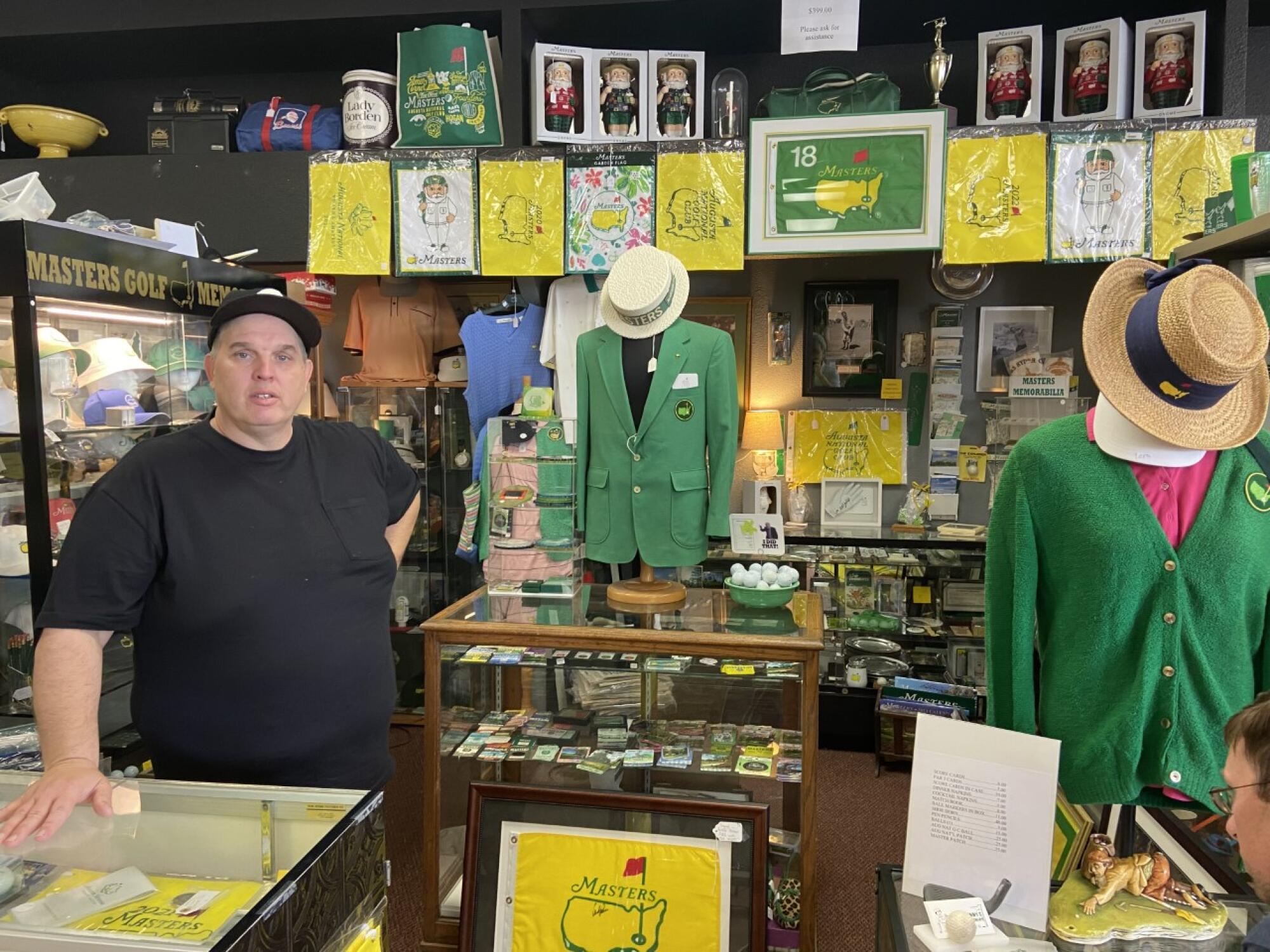
But the vault is located beneath the pro shop, which is accessible to members and their guests. On the other side of the door are 24 steps down, with motion-sensitive lights that gradually illuminate the room below.
At the bottom of the stairs is an exposed brick wall, curved like the ceiling of a wine cellar, with Byron Nelson’s green jacket under glass and museum lighting. On either side are two large touch-screen displays. Those use video and three-dimensional graphics to tell the story of how the jacket tradition came to be.
The other half of this space is a glass storefront that requires fingerprint entry. On display is the club’s oldest green jacket in its archives, which dates to the 1930s, has a different logo — a far more rudimentary outline of the United States with a golf flag planted in Georgia — and looks to be made of a heavy felt.
Also in the room are two leather arm chairs, decorated with tiny Augusta logos, and the bust of a mannequin draped in a marked-up and deconstructed green jacket. The club has a tailor on retainer.
Behind that are two stacked rows of neatly organized green jackets, about 100 of them from large to small, with one section dedicated to green jackets for female members.
The Masters and Augusta National, a tradition like no other, has inspired golf fans to recreate the holes and scenes in backyards all over the country.
When a new member joins the club, he or she meets with club chairman Fred Ridley and a tailor in the vault and is fitted for a jacket, which features the logo on a patch over the left breast pocket. Behind two panels are hidden liquor cabinets, one for Scotch and the other for bourbon.
The already-tailored green jackets of the members are stored in another location at the club.
Members buy their own jackets, and there are different tiers, tailors and fabrics, depending on price. They typically own more than one, which comes in handy on those warm Georgia days. The original rationale for the jacket was to make club members easily identifiable for tournament patrons seeking information on the grounds.
And the jackets are not supposed to leave the club. Only the current champion can take it home for his reign.
Spieth’s jacket was huge on him because he declined to hand it over for alterations. He took off for New York shortly after winning and wanted to keep the jacket in his possession.
Round 2 of the Masters has been suspended until Friday after winds caused three trees to fall near spectators. Augusta National says no one was injured.
“After that, I just had it with me everywhere and I never got it fixed,” he said. “I think they have done it here since because the arms certainly fit a lot better. I left a little room just in case I put on a few pounds over the years.”
His jacket was so billowy he brought to mind Talking Heads, lead singer David Byrne in his big suit. Yet Spieth still wore the jacket to NBA games, NHL games and football games at his alma mater, University of Texas. When it wasn’t draped over him, it was slung over his shoulder.
“Maybe the coolest part is everywhere I went I traveled with a little hanging bag, and on the bag that holds the jacket it says, `2015 Masters Champion’ or whatever on it,” he said. “So it was just kind of cool to look in my closet every week and see that. I’d love to have another one, maybe a little bigger and fit it to my size.”
Nicklaus didn’t have a green jacket until 1998.
“I had a 46 long they put on me, and I was a 43 regular,” he recalled of his first Masters win in 1963, when he was a pudgy 23-year-old.

Although defending champions typically have a green jacket waiting for them when they return the next year, somehow Nicklaus didn’t get one. So he borrowed one from Augusta member Tom Dewey, the former New York governor and presidential candidate. It fit perfectly.
So Dewey didn’t defeat Truman — as the Chicago Daily Tribune eventually learned — but he did clothe Nicklaus.
When Nicklaus won his fourth Masters in 1972 — the year after Dewey died — his borrowed jacket was looking a little threadbare. So the Golden Bear, who had an endorsement deal with Hart, Schaffner and Marx, asked that Cincinnati-based clothier to make him a green jacket.
Nicklaus once said he wasn’t satisfied with the material or color, even though they made those jackets in 1949 and did so for the next few decades. Hamilton Tailoring Co. of Cincinnati made the jackets from 1967-2004, and today the makers include Henry Poole & Co. of London, Oxxford Clothes of Chicago and Hickey Freeman of Rochester, N.Y.
The jackets are a very specific shade of green, Pantone 342, and the color is trademarked. It’s a different hue than anything sold by the club.
It might not have been his favorite, but Nicklaus wore that jacket shortly past his fifth victory in 1975, then went back to borrowing coats from members. He never told the club he didn’t have one of his own.
“Finally, in 1998, a week before the tournament, I was having lunch with [then chairman] Jack Stephens, and I told him the story that I didn’t have a green jacket and never had a green jacket,” Nicklaus said. “He said, `What?’
“I said, `No, I’ve won the tournament five times, six times and nobody has ever given me a green jacket.’ So I went home, came back over the weekend and there was a note in my locker that said, `You will go to the pro shop, and you will be fit for your green jacket.’ Thank you very much.”
Player, a three-time winner and first international champion, got his own jacket … and promptly left with it. Times were different then. Even the reigning champions were to leave the jacket at the club.
“I was extremely excited to say the least,” he said of his first win in 1961. “And so I take the jacket, I’m going to South Africa the next day, and I take it with me. … I took the jacket back home.
“Three days later, the phone goes, `Good morning, Gary. This is Clifford Roberts. Did you take the jacket back home?’ ”
“I did,” Player told the Augusta National co-founder.
The classic white coveralls worn by caddies at the Masters have a long history, and tradition is the winner’s caddie keeps the outfit as a memento.
“Well, nobody ever takes the jacket off the ground.”
Recalled Player: “I thought very quickly. I said, `Mr. Roberts, why don’t you come and fetch it?’ He did see the funny side of it. He said to me, `But don’t ever wear it in public.’ ”
Player complied, putting the jacket in a plastic bag and storing it for the year.
Among the club’s rigid rules: The green jackets cannot be sold or given to third parties under any circumstances and, to ensure authenticity, each jacket is marked for identification.
Regardless, some have slipped through the cracks. A few have been sold at auction, including the one found at that thrift store, which in 2017 commanded $140,000.
Billy Casper, the 1970 champion, loved Augusta so much that he was buried in his green jacket.
Stands to reason. It’s a members-only jacket that is forever in style.
More to Read
Go beyond the scoreboard
Get the latest on L.A.'s teams in the daily Sports Report newsletter.
You may occasionally receive promotional content from the Los Angeles Times.

